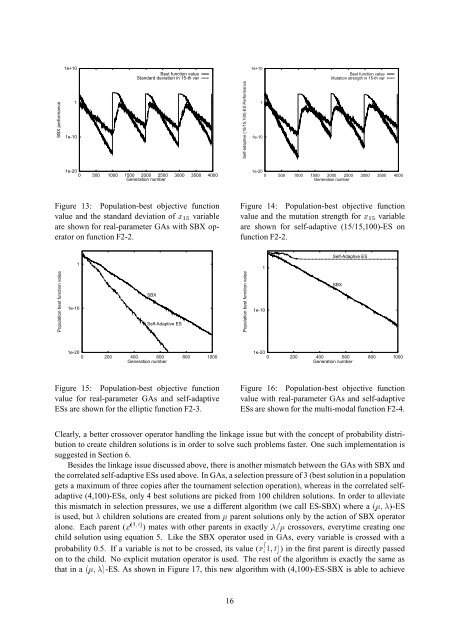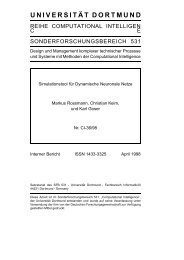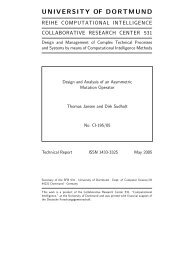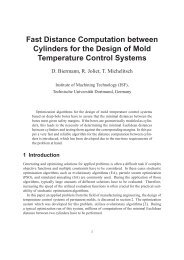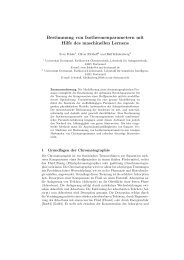Self-Adaptive Genetic Algorithms with Simulated Binary Crossover
Self-Adaptive Genetic Algorithms with Simulated Binary Crossover
Self-Adaptive Genetic Algorithms with Simulated Binary Crossover
You also want an ePaper? Increase the reach of your titles
YUMPU automatically turns print PDFs into web optimized ePapers that Google loves.
SBX performance<br />
1e+10<br />
1<br />
1e-10<br />
Best function value<br />
Standard deviation in 15-th var<br />
1e-20<br />
0 500 1000 1500 2000 2500<br />
Generation number<br />
3000 3500 4000<br />
Figure 13: Population-best objective function<br />
value and the standard deviation ofx15variable<br />
are shown for real-parameter GAs <strong>with</strong> SBX operator<br />
on function F2-2.<br />
Population best function value<br />
1<br />
1e-10<br />
SBX<br />
<strong>Self</strong>-<strong>Adaptive</strong> ES<br />
1e-20<br />
0 200 400 600<br />
Generation number<br />
800 1000<br />
Figure 15: Population-best objective function<br />
value for real-parameter GAs and self-adaptive<br />
ESs are shown for the elliptic function F2-3.<br />
<strong>Self</strong>-adaptive (15/15,100)-ES Performance<br />
1e+10<br />
1<br />
1e-10<br />
Best function value<br />
Mutation strength in 15-th var<br />
1e-20<br />
0 500 1000 1500 2000 2500<br />
Generation number<br />
3000 3500 4000<br />
Figure 14: Population-best objective function<br />
value and the mutation strength forx15variable<br />
are shown for self-adaptive (15/15,100)-ES on<br />
function F2-2.<br />
Population best function value<br />
1<br />
1e-10<br />
<strong>Self</strong>-<strong>Adaptive</strong> ES<br />
SBX<br />
1e-20<br />
0 200 400 600<br />
Generation number<br />
800 1000<br />
Figure 16: Population-best objective function<br />
value <strong>with</strong> real-parameter GAs and self-adaptive<br />
ESs are shown for the multi-modal function F2-4.<br />
Clearly, a better crossover operator handling the linkage issue but <strong>with</strong> the concept of probability distribution<br />
to create children solutions is in order to solve such problems faster. One such implementation is<br />
suggested in Section 6.<br />
Besides the linkage issue discussed above, there is another mismatch between the GAs <strong>with</strong> SBX and<br />
the correlated self-adaptive ESs used above. In GAs, a selection pressure of 3 (best solution in a population<br />
gets a maximum of three copies after the tournament selection operation), whereas in the correlated selfadaptive<br />
(4,100)-ESs, only 4 best solutions are picked from 100 children solutions. In order to alleviate<br />
this mismatch in selection pressures, we use a different algorithm (we call ES-SBX) where a(;)-ES<br />
is used, but children solutions are created from parent solutions only by the action of SBX operator<br />
alone. Each parent (x(1;t)) mates <strong>with</strong> other parents in exactly=crossovers, everytime creating one<br />
child solution using equation 5. Like the SBX operator used in GAs, every variable is crossed <strong>with</strong> a<br />
probability 0.5. If a variable is not to be crossed, its value (x(i1;t)) in the first parent is directly passed<br />
on to the child. No explicit mutation operator is used. The rest of the algorithm is exactly the same as<br />
that in a(;)-ES. As shown in Figure 17, this new algorithm <strong>with</strong> (4,100)-ES-SBX is able to achieve<br />
16


